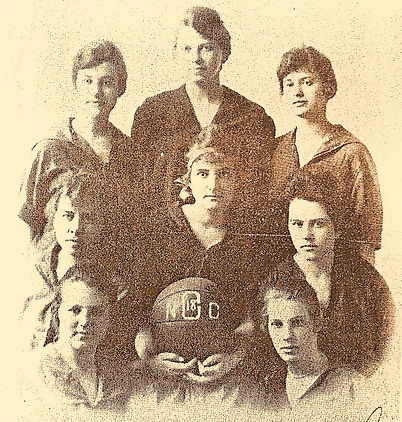Nebraska Central College
Central City, Nebraska
1899-1953
E-Travel
The Central City Public Library kindly loaned me Nebraska Central College and Academy: 1899-1930. This together with newspaper clippings provided information on the history of the school. Nebraska Christian School, inheritor of the campus, maintains a website with photos of the Administration Building. William Penn College provided a scan of the N.C.C. seal.

History
Feeling the need of a school “where their children might be educated under Friendly influence,” the Nebraska Society of Friends opened a college in Central City in 1899, initially called Nebraska Central Academy. The academy opened with 40 students and eight faculty. In addition to regular college work with classical, literary, scientific, biblical, and normal courses of study, students could enroll in programs of elocution, music, physical culture, art or commerce. There was also a grammar department offering two years of high school level work.
Nebraska Central students attended chapel daily, and most walked into Central City to attend religious services twice each Sunday. The local chapters of the Y.M.C.A., the Y.W.C.A. and later the S.C.A. provided much of the social life of the school. Until 1924 there were Saturday classes but no Monday classes, the school determining that Monday was the better day for both study and work.
The Ionian Literary Society was formed in the second year of the school’s existence, beginning Nebraska Central’s strong tradition in speech and debate. Later literary societies included Spartan, Athenian, Hesperian, Delphian and Whittierian—the last named for the great Quaker poet.
.
Enrollment at Nebraska Central was never robust—especially after the academy was dropped in 1929. As a result, the financial status of the college was always precarious. In 1952 enrollment dropped to 35 students. When only 20 enrolled a year later, the school was forced to close. In 1958 school records and memorabilia went to William Penn College at Oskaloosa, IA.

Bricks and Mortar
The Administration Building for Nebraska Central College was built by the North Nebraska Conference Seminary in 1886. It was located two miles northwest of the business district of Central City, a town of 1,400. After the Methodists were forced to close that school, the Nebraska Society of Friends purchased the three-story brick and stone building in 1896. Even before the school opened, three families of faculty occupied living quarters in the basement of the building.
In 1900 two new buildings were added to the campus—Whittier Hall, a dormitory for women; and Hord Hall, a dormitory for men, that included a gymnasium and laboratories.
In 1955, after Nebraska Central College closed, the campus was used by Calvary Life College. In 1958 the campus was purchased by Nebraska Christian School, and the Administration Building still serves as their main building.
Former NCC Administration Building, now Nebraska Christian School. (Courtesy of Nebraska Christian School)
Sports
Team name: Fighting Quakers
Colors: Old Gold and Maroon
Nebraska College students were keen for sports. An Athletic Association was formed, raising funds for athletic teams. They organized a football team and played a game in the first year. The faculty then banned football until 1904. That year the team won one of four games. However in 1905 the students themselves voted to ban football as being dangerous and brutalizing. After World War I, when the enrollment of male students increased, football returned to the campus, and Nebraska Central became a member of the Nebraska State Conference playing Dana, Omaha, Kearney Normal, Midland, Hastings, Cotner, Grand Island, York, and Concordia. N.C.C. teams enjoyed little success in most seasons
In 1951 Nebraska Central again made national news in football. With only 15 male students to choose from, N.C.C. enlisted 13 of these for the football team. When one was injured, the team had only one substitute. Coach Laurel Ellis, with college eligibility remaining, filled in as a substitute wherever needed. Averaging less than 165 pounds per man, the Quakers still won two games.

1918 Women's basketball team. (Courtesy of Myrick County Historical Society)
Note: Images are used in accordance with their “terms of use” as I understand those terms. Recopying or republishing these images may be restricted or forbidden